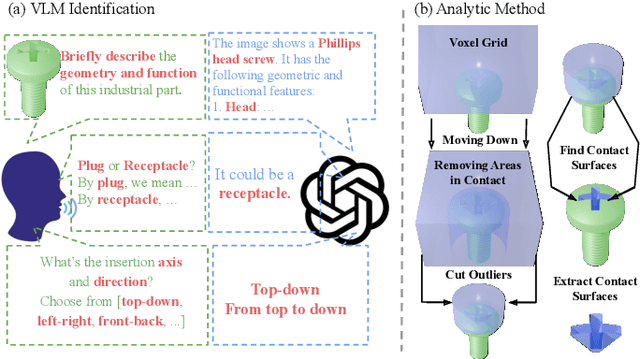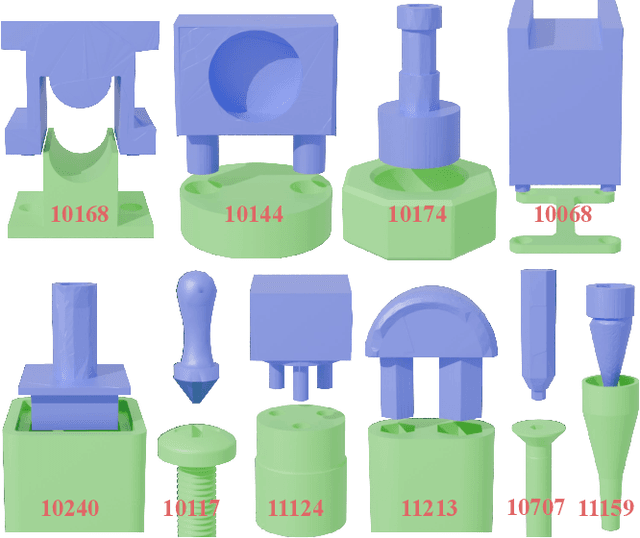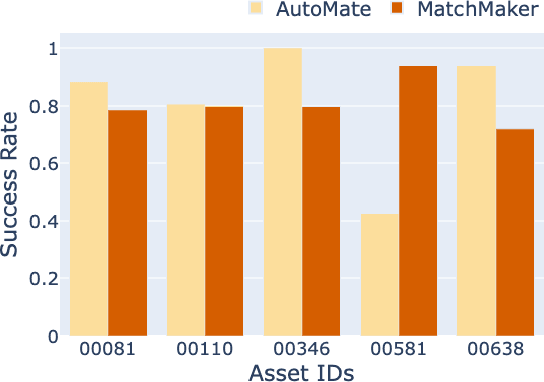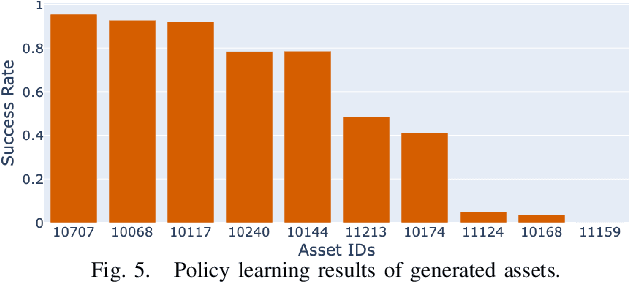Kaichun Mo
Slot-Level Robotic Placement via Visual Imitation from Single Human Video
Apr 02, 2025



Abstract:The majority of modern robot learning methods focus on learning a set of pre-defined tasks with limited or no generalization to new tasks. Extending the robot skillset to novel tasks involves gathering an extensive amount of training data for additional tasks. In this paper, we address the problem of teaching new tasks to robots using human demonstration videos for repetitive tasks (e.g., packing). This task requires understanding the human video to identify which object is being manipulated (the pick object) and where it is being placed (the placement slot). In addition, it needs to re-identify the pick object and the placement slots during inference along with the relative poses to enable robot execution of the task. To tackle this, we propose SLeRP, a modular system that leverages several advanced visual foundation models and a novel slot-level placement detector Slot-Net, eliminating the need for expensive video demonstrations for training. We evaluate our system using a new benchmark of real-world videos. The evaluation results show that SLeRP outperforms several baselines and can be deployed on a real robot.
SIGHT: Single-Image Conditioned Generation of Hand Trajectories for Hand-Object Interaction
Mar 28, 2025Abstract:We introduce a novel task of generating realistic and diverse 3D hand trajectories given a single image of an object, which could be involved in a hand-object interaction scene or pictured by itself. When humans grasp an object, appropriate trajectories naturally form in our minds to use it for specific tasks. Hand-object interaction trajectory priors can greatly benefit applications in robotics, embodied AI, augmented reality and related fields. However, synthesizing realistic and appropriate hand trajectories given a single object or hand-object interaction image is a highly ambiguous task, requiring to correctly identify the object of interest and possibly even the correct interaction among many possible alternatives. To tackle this challenging problem, we propose the SIGHT-Fusion system, consisting of a curated pipeline for extracting visual features of hand-object interaction details from egocentric videos involving object manipulation, and a diffusion-based conditional motion generation model processing the extracted features. We train our method given video data with corresponding hand trajectory annotations, without supervision in the form of action labels. For the evaluation, we establish benchmarks utilizing the first-person FPHAB and HOI4D datasets, testing our method against various baselines and using multiple metrics. We also introduce task simulators for executing the generated hand trajectories and reporting task success rates as an additional metric. Experiments show that our method generates more appropriate and realistic hand trajectories than baselines and presents promising generalization capability on unseen objects. The accuracy of the generated hand trajectories is confirmed in a physics simulation setting, showcasing the authenticity of the created sequences and their applicability in downstream uses.
MatchMaker: Automated Asset Generation for Robotic Assembly
Mar 07, 2025



Abstract:Robotic assembly remains a significant challenge due to complexities in visual perception, functional grasping, contact-rich manipulation, and performing high-precision tasks. Simulation-based learning and sim-to-real transfer have led to recent success in solving assembly tasks in the presence of object pose variation, perception noise, and control error; however, the development of a generalist (i.e., multi-task) agent for a broad range of assembly tasks has been limited by the need to manually curate assembly assets, which greatly constrains the number and diversity of assembly problems that can be used for policy learning. Inspired by recent success of using generative AI to scale up robot learning, we propose MatchMaker, a pipeline to automatically generate diverse, simulation-compatible assembly asset pairs to facilitate learning assembly skills. Specifically, MatchMaker can 1) take a simulation-incompatible, interpenetrating asset pair as input, and automatically convert it into a simulation-compatible, interpenetration-free pair, 2) take an arbitrary single asset as input, and generate a geometrically-mating asset to create an asset pair, 3) automatically erode contact surfaces from (1) or (2) according to a user-specified clearance parameter to generate realistic parts. We demonstrate that data generated by MatchMaker outperforms previous work in terms of diversity and effectiveness for downstream assembly skill learning. For videos and additional details, please see our project website: https://wangyian-me.github.io/MatchMaker/.
Cosmos World Foundation Model Platform for Physical AI
Jan 07, 2025



Abstract:Physical AI needs to be trained digitally first. It needs a digital twin of itself, the policy model, and a digital twin of the world, the world model. In this paper, we present the Cosmos World Foundation Model Platform to help developers build customized world models for their Physical AI setups. We position a world foundation model as a general-purpose world model that can be fine-tuned into customized world models for downstream applications. Our platform covers a video curation pipeline, pre-trained world foundation models, examples of post-training of pre-trained world foundation models, and video tokenizers. To help Physical AI builders solve the most critical problems of our society, we make our platform open-source and our models open-weight with permissive licenses available via https://github.com/NVIDIA/Cosmos.
3D-MVP: 3D Multiview Pretraining for Robotic Manipulation
Jun 26, 2024



Abstract:Recent works have shown that visual pretraining on egocentric datasets using masked autoencoders (MAE) can improve generalization for downstream robotics tasks. However, these approaches pretrain only on 2D images, while many robotics applications require 3D scene understanding. In this work, we propose 3D-MVP, a novel approach for 3D multi-view pretraining using masked autoencoders. We leverage Robotic View Transformer (RVT), which uses a multi-view transformer to understand the 3D scene and predict gripper pose actions. We split RVT's multi-view transformer into visual encoder and action decoder, and pretrain its visual encoder using masked autoencoding on large-scale 3D datasets such as Objaverse. We evaluate 3D-MVP on a suite of virtual robot manipulation tasks and demonstrate improved performance over baselines. We also show promising results on a real robot platform with minimal finetuning. Our results suggest that 3D-aware pretraining is a promising approach to improve sample efficiency and generalization of vision-based robotic manipulation policies. We will release code and pretrained models for 3D-MVP to facilitate future research. Project site: https://jasonqsy.github.io/3DMVP
URDFormer: A Pipeline for Constructing Articulated Simulation Environments from Real-World Images
May 19, 2024



Abstract:Constructing simulation scenes that are both visually and physically realistic is a problem of practical interest in domains ranging from robotics to computer vision. This problem has become even more relevant as researchers wielding large data-hungry learning methods seek new sources of training data for physical decision-making systems. However, building simulation models is often still done by hand. A graphic designer and a simulation engineer work with predefined assets to construct rich scenes with realistic dynamic and kinematic properties. While this may scale to small numbers of scenes, to achieve the generalization properties that are required for data-driven robotic control, we require a pipeline that is able to synthesize large numbers of realistic scenes, complete with 'natural' kinematic and dynamic structures. To attack this problem, we develop models for inferring structure and generating simulation scenes from natural images, allowing for scalable scene generation from web-scale datasets. To train these image-to-simulation models, we show how controllable text-to-image generative models can be used in generating paired training data that allows for modeling of the inverse problem, mapping from realistic images back to complete scene models. We show how this paradigm allows us to build large datasets of scenes in simulation with semantic and physical realism. We present an integrated end-to-end pipeline that generates simulation scenes complete with articulated kinematic and dynamic structures from real-world images and use these for training robotic control policies. We then robustly deploy in the real world for tasks like articulated object manipulation. In doing so, our work provides both a pipeline for large-scale generation of simulation environments and an integrated system for training robust robotic control policies in the resulting environments.
RHOBIN Challenge: Reconstruction of Human Object Interaction
Jan 07, 2024Abstract:Modeling the interaction between humans and objects has been an emerging research direction in recent years. Capturing human-object interaction is however a very challenging task due to heavy occlusion and complex dynamics, which requires understanding not only 3D human pose, and object pose but also the interaction between them. Reconstruction of 3D humans and objects has been two separate research fields in computer vision for a long time. We hence proposed the first RHOBIN challenge: reconstruction of human-object interactions in conjunction with the RHOBIN workshop. It was aimed at bringing the research communities of human and object reconstruction as well as interaction modeling together to discuss techniques and exchange ideas. Our challenge consists of three tracks of 3D reconstruction from monocular RGB images with a focus on dealing with challenging interaction scenarios. Our challenge attracted more than 100 participants with more than 300 submissions, indicating the broad interest in the research communities. This paper describes the settings of our challenge and discusses the winning methods of each track in more detail. We observe that the human reconstruction task is becoming mature even under heavy occlusion settings while object pose estimation and joint reconstruction remain challenging tasks. With the growing interest in interaction modeling, we hope this report can provide useful insights and foster future research in this direction. Our workshop website can be found at \href{https://rhobin-challenge.github.io/}{https://rhobin-challenge.github.io/}.
Towards Learning Geometric Eigen-Lengths Crucial for Fitting Tasks
Dec 25, 2023Abstract:Some extremely low-dimensional yet crucial geometric eigen-lengths often determine the success of some geometric tasks. For example, the height of an object is important to measure to check if it can fit between the shelves of a cabinet, while the width of a couch is crucial when trying to move it through a doorway. Humans have materialized such crucial geometric eigen-lengths in common sense since they are very useful in serving as succinct yet effective, highly interpretable, and universal object representations. However, it remains obscure and underexplored if learning systems can be equipped with similar capabilities of automatically discovering such key geometric quantities from doing tasks. In this work, we therefore for the first time formulate and propose a novel learning problem on this question and set up a benchmark suite including tasks, data, and evaluation metrics for studying the problem. We focus on a family of common fitting tasks as the testbed for the proposed learning problem. We explore potential solutions and demonstrate the feasibility of learning eigen-lengths from simply observing successful and failed fitting trials. We also attempt geometric grounding for more accurate eigen-length measurement and study the reusability of the learned eigen-lengths across multiple tasks. Our work marks the first exploratory step toward learning crucial geometric eigen-lengths and we hope it can inspire future research in tackling this important yet underexplored problem.
* ICML 2023. Project page: https://yijiaweng.github.io/geo-eigen-length
STOW: Discrete-Frame Segmentation and Tracking of Unseen Objects for Warehouse Picking Robots
Nov 04, 2023



Abstract:Segmentation and tracking of unseen object instances in discrete frames pose a significant challenge in dynamic industrial robotic contexts, such as distribution warehouses. Here, robots must handle object rearrangement, including shifting, removal, and partial occlusion by new items, and track these items after substantial temporal gaps. The task is further complicated when robots encounter objects not learned in their training sets, which requires the ability to segment and track previously unseen items. Considering that continuous observation is often inaccessible in such settings, our task involves working with a discrete set of frames separated by indefinite periods during which substantial changes to the scene may occur. This task also translates to domestic robotic applications, such as rearrangement of objects on a table. To address these demanding challenges, we introduce new synthetic and real-world datasets that replicate these industrial and household scenarios. We also propose a novel paradigm for joint segmentation and tracking in discrete frames along with a transformer module that facilitates efficient inter-frame communication. The experiments we conduct show that our approach significantly outperforms recent methods. For additional results and videos, please visit \href{https://sites.google.com/view/stow-corl23}{website}. Code and dataset will be released.
Where2Explore: Few-shot Affordance Learning for Unseen Novel Categories of Articulated Objects
Sep 14, 2023



Abstract:Articulated object manipulation is a fundamental yet challenging task in robotics. Due to significant geometric and semantic variations across object categories, previous manipulation models struggle to generalize to novel categories. Few-shot learning is a promising solution for alleviating this issue by allowing robots to perform a few interactions with unseen objects. However, extant approaches often necessitate costly and inefficient test-time interactions with each unseen instance. Recognizing this limitation, we observe that despite their distinct shapes, different categories often share similar local geometries essential for manipulation, such as pullable handles and graspable edges - a factor typically underutilized in previous few-shot learning works. To harness this commonality, we introduce 'Where2Explore', an affordance learning framework that effectively explores novel categories with minimal interactions on a limited number of instances. Our framework explicitly estimates the geometric similarity across different categories, identifying local areas that differ from shapes in the training categories for efficient exploration while concurrently transferring affordance knowledge to similar parts of the objects. Extensive experiments in simulated and real-world environments demonstrate our framework's capacity for efficient few-shot exploration and generalization.
 Add to Chrome
Add to Chrome Add to Firefox
Add to Firefox Add to Edge
Add to Edge